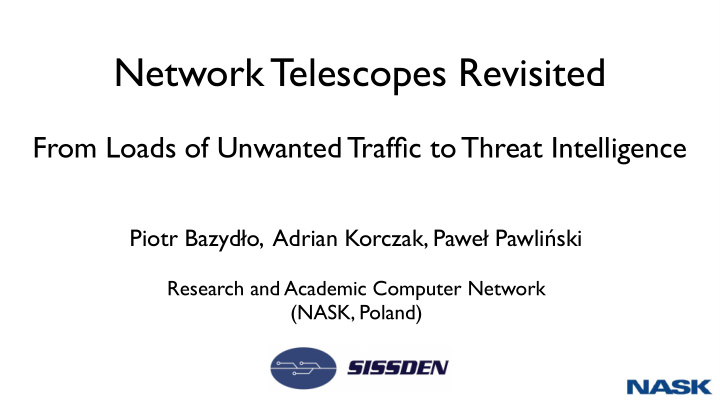



Network T elescopes Revisited From Loads of Unwanted Traffjc to Threat Intelligence Piotr Bazydło, Adrian Korczak, Paweł Pawliński Research and Academic Computer Network (NASK, Poland)
Who are we Piotr Bazydło Head of Network Security Methods Team NASK @chudyPB piotr.bazydlo@nask.pl Adrian Korczak Network Security Methods Team NASK adrian.korczak@nask.pl Paweł Pawliński CERT Polska pawel.pawlinski@cert.pl
Network T elescope ● Also known as darknet or blackhole. ● Unused IP address space. ● No legitimate network traffjc should be observed. ● First (?) & largest telescope (approx /8):
Network T elescope In practice, we can see a lot of different activities: ● Misconfjguration of network devices/applications. ● Scanning. ● Backscatter from DoS attacks. ● Exploitation attempts (UDP). ● Weird stuff.
DoS attacks (backscatter)
What we want to achieve? ● Detect large-scale malicious events (botnets, exploits). ● Detect attacks on interesting targets. ● Track activities of specifjc actors responsible. ● Understand the dynamics (trends).
Problems ● How to group packets? ● How to classify them into events? ● How to fjnd interesting events? ● How to identify actors? ● How to analyze trends?
Our approach Traffic going to network telescope 1. Monitored IPv4 space: > 100 000 addresses 2. Analyze captured traffjc every 5 minutes. Stats: ~ 10 000 pps ~ 25 000 000 000 packets per month 80% = TCP
Traffic going to network telescope T wo parsing scripts: ● Parser L4 – up to 4 th OSI layer. written in C++, uses libtins library. Parser L7 Parser L7 payload up to L4 ● Parser 7 – parsing of 7 th OSI layer. written in python, uses dpkt library
Traffic going to network telescope Parser Parser L7 up to L4 Initial aggregation Redis Aggregator Aggregator Aggregator Broker 1 Broker ... 1 ... N
Traffic going to network telescope Analysis Analyzer Analyzer Analyzer TCP UDP DNS Parser Parser L7 up to L4 Analyzer Analyzer Analyzer ... SIP amplifiers Initial aggregation Redis Aggregator Aggregator Aggregator Broker 1 Broker ... 1 ... N
Elastic Traffic going to Search network telescope Analysis Analyzer Analyzer Analyzer TCP UDP DNS Parser Parser L7 up to L4 Analyzer Analyzer Analyzer ... SIP amplifiers Initial aggregation Redis Aggregator Aggregator Aggregator Broker 1 Broker ... 1 ... N
Case study 1 Botnet Fingerprinting
Botnet fjngerprinting
Botnet fjngerprinting Packets with SEQ = IP_DST
Botnet fjngerprinting
Botnet fjngerprinting
Botnet fjngerprinting In total, about 45 000 unique IP addresses were identifjed. Distribution of source IPs
Case study 2 Memcached
Memcached
Memcached Github 1.3 Tbps DoS Reported 1.7 Tbps DoS
Memcached Github 1.3 Tbps DoS Reported 1.7 Tbps DoS
Day 1 – 20.02 (fjrst scan) ● Only 4 IP addresses ● Source: DigitalOcean, UK ● Duration: 25 minutes ● Constant source port per source IP ● One payload used (memcached statistics)
Day 5 – 24.02 (new actor) ● Only 1 IP addresses ● Source: AS 27176, DataWagon LLC, US ● Small hosting with anti-DDoS ● Randomized source ports ● New payload ● Scan lasted longer: 3 hours
And so on… Pre-GitHub scanners Distribution of source IPs ● About 60 IP addresses. ● Several scanning patterns.
And so on… Post-GitHub scanners Distribution of source IPs ● About 315 IP addresses. ● Multiple scanning patterns.
Looking deeper into packets
PGA ● PGA = custom code to generate packets ● Improve DDoS Botnet Ya Liu, 360 Netlab, Botconf 4 th edition, Dec 2016 Tracking with Honeypots , ● Usually simple operations, examples ● constant values ● byte swap ● incrementation ● Leaves patterns that can be used for IDS ● Our tool detects patterns and creates new signatures
PGA examples 2. XoR.DDoS PGA: 1. Mirai: IP_ID = SPORT TCP_SEQ = IP_DST TCP_SEQ[1:2] = IP_ID
PGA example
Signatures everywhere SYN FLOOD on IP belonging to Google – full of PGA signatures.
Signatures everywhere SYN FLOOD on IP belonging to Google – full of PGA signatures. 1. SPORT = TCP_SEQ[1:2] 2. TCP_SEQ[3:4] = 0xFFFF 3. SPORT = IP_SRC[3:4] 1 2 3
Operations
Operational value of network telescopes ● Raw output from analyzers is not actionable (too many events) ● Scans →! abuse notifjcations (automated for high confjdence events) ● PGA fjngerprinting →! Shadowserver remediation feeds 1 ● DoS attacks →! situational awareness & alerts ● Automated feeds provide limited “intelligence” 2 3
DoS backscatter for the Polish IPv4 space (color = PGA fjngerprint)
Sharing threat information ● Automated distribution of abuse reports & IoCs ● Free 1 ● > 100 active participating entities ● > 50 data sources 2 3 ● Formats: JSON & CSV & more
Interested in getting the data? ● Network owners: send an email to n6@cert.pl to sign up ● Usually working with national CSIRTs 1 2 3
Aiming for actual intelligence ● In-depth analysis of events extracted from the traffjc ● insight into TTP ● more diffjcult to automate ● Anomaly / trend detection: ● forecast exploitation campaigns. 1 ● new campaigns 2 3 ● Attribute activities to botnets / actors
Future plans ● Combine network telescopes with other data sources Honeypots, sandboxes, botnet tracking ● Research collaboration: 1 Looking for help in linking PGA signatures to tools / malware 2 3
https://sissden.eu This project has received funding from the European Union’s Horizon 2020 research and innovation programme under grant agreement No 700176.
Recommend
More recommend